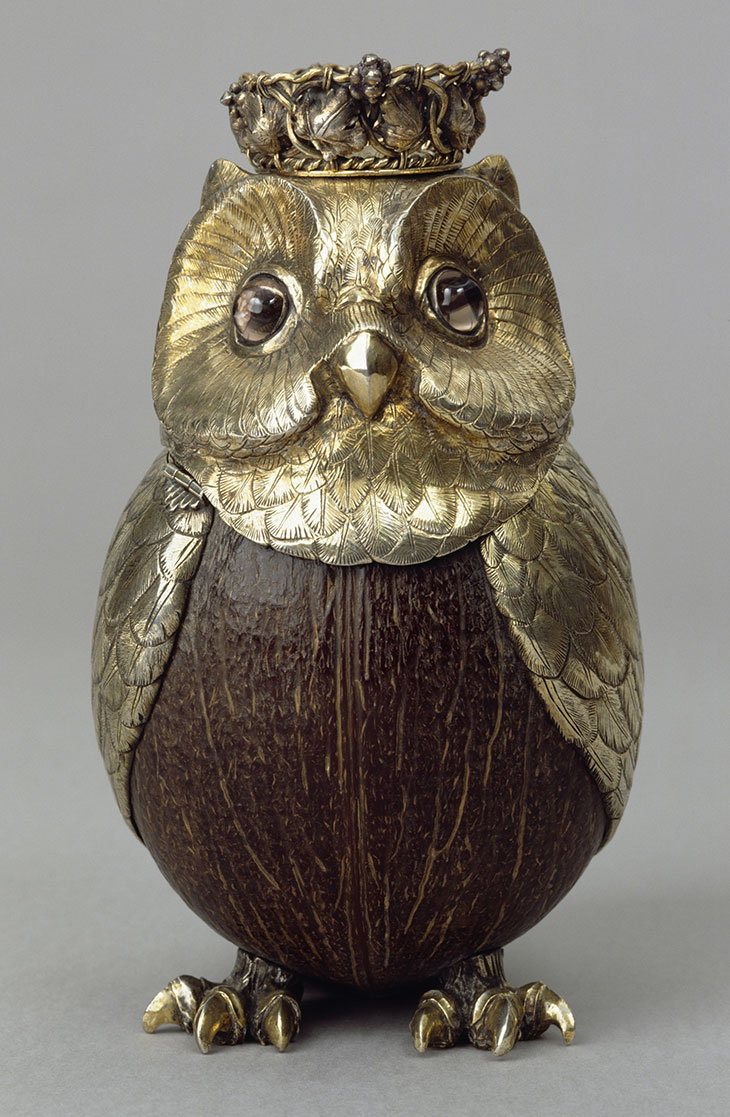Julius Wernher (1850–1912) was a Randlord: one of the European businessmen or adventurers who made a fortune from their control of the diamond and gold industries in South Africa at the turn of the 19th century. Since 2002 English Heritage have hosted the bulk of Wernher’s extensive art collection at Ranger’s House by Greenwich Park, and they are anxious for you to understand that he was one of the good ones.
Oval dish with moulded eel, fish and crab (1565–75), France. © Trustees of the Wernher Foundation/English Heritage

Recent controversies surrounding statues of Cecil Rhodes, the most infamous of the Randlords, in whose De Beers Consolidated Diamond Company Wernher’s firm eventually held a controlling interest, might otherwise take some of the gleam off the reopening to the public of this remarkable collection. We learn from the exhibition guidebook that while, admittedly, Wernher did exploit African labour in the mines he owned and managed, he also ‘made sure that he diversified his business interests there in later years to develop housing, transport and farming’.
In 2001 the Wernher Foundation loaned the collection – spanning Renaissance paintings and medieval sculpture, jewellery, ceramics, bronzes, enamels, tapestries, and furniture – to English Heritage for 125 years. A few years earlier the Wernher family had sold Luton Hoo, the Bedfordshire estate that housed it in grand style for nearly a century – although not before several of its treasures, including the Fabergé eggs brought by Wernher’s Russian daughter-in-law, Lady Zia (a great-granddaughter of Tsar Nicholas I), had been stolen.
The Love of Angels (1864), Giulio Bergonzoli. Photo: Historic England; © Trustees of the Wernher Foundation

Wernher himself never lived in Ranger’s House, an elegant Palladian redbrick built in the 1720s. Nevertheless, the exhibition still contrives to make you feel as if you are the not entirely welcome visitors to the Wernher family’s ancestral seat. There are the eccentric opening times: it is closed on Thursdays, Fridays and Saturdays until October, when it will shut its doors until next spring, and a sign on the railings informs visitors that it may nevertheless close without notice on any of the remaining days. The 11 rooms are modelled on Wernher’s arrangement of his collection both at Luton Hoo and at Bath House, his Mayfair townhouse. For the first time visitors are now able to explore the more than 700 pieces without being shadowed by a tour guide, but gallery attendants follow you unsubtly between rooms, stepping in if you lean too far forward over the rope barrier towards the distant Sèvres porcelain, and explaining that this may set off the extra-sensitive alarm sensors.
Such quirks are fitting for a collection as idiosyncratic as it fascinating. One of most significant idiosyncrasies is that it is in essence two collections at once. The first might belong to any wealthy 19th-century gentleman, furnishing his town and country residences in suitable style. Even by these standards Wernher’s fortune was exceptional; when he died it was reported that his will was the largest Somerset House had ever seen. In the Pink Drawing Room, exquisite Sèvres porcelain bowls sit on a table surrounded by Beauvais-upholstered chairs, behind which Joshua Reynolds portraits are arranged along the wall. Framed by a bow window at the end of the Long Drawing Room is Giulio Bergonzoli’s melodramatic marble sculpture, Love of Angels (1864): an angel embraces his topless lover, their blank faces hovering over one another in anticipation of a kiss.
Memento mori pendant, front and back views (c. 1500). © Trustees of the Wernher Foundation/English Heritage

The more interesting part of the collection reflects its owner’s passion for Renaissance and medieval art. This included paintings, although the most valuable were sold by the Wernher Foundation to finance the preservation of the remainder of the holdings. A Titian portrait of Giacoma Doria from the 1530s is now at the Ashmolean; Diana and Her Nymphs Hunting (1636) by Rubens was bought by the Prado. Despite taking some advice from Wilhelm von Bode, the distinguished art historian responsible for re-establishing the Musée des Beaux Arts in Strasbourg after the Franco-Prussian War, Wernher followed his own eye. He prized craftsmanship and what he called the ‘splendidly ugly’. The curators at Ranger’s House take this to mean works of unusual subject matter: a 19th-century silver-gilt, coconut cup in the shape of an owl; a ghoulish 16th-century ivory memento mori, on one side a noblewoman and on the other her skeleton, crawling with worms and salamanders. I wonder if it might also be about pieces produced for a purpose beyond being beautiful – whether for worship, declaration of political allegiance, or something to eat off – that through the brilliance of their execution achieve artistic distinction.
Silver-gilt coconut cup formed as an owl (19th century), Germany. Photo: Historic England; © Trustees of the Wernher Foundation

The Red Room, a close replica of a similar room in Bath House, contains an extraordinary variety of these splendid objects. In one cabinet, ivory diptychs of Pyramus and Thisbe and of the crucifixion jostle for space with backgammon pieces, a tankard, and a teapot. In another a small portrait of John Calvin finds itself cheek by jowl with a painted dish depicting Venus and Mars. Other rooms concentrate on a single material. There is a room of 15th-century Limoges enamel; another of Renaissance bronzes; and one of ceramics, including some particularly beautiful Iznik dishes from Turkey. Taken together they make a strong argument for the way expert craftsmanship and the elusive, shifting standards of ‘taste’ transform natural materials into objects of both practical application and rare value. Just what you might expect from the collection of a man who made his fortune cutting and selling diamonds.
The Wernher Collection at Ranger’s House, London is open to the public until 30 September.



